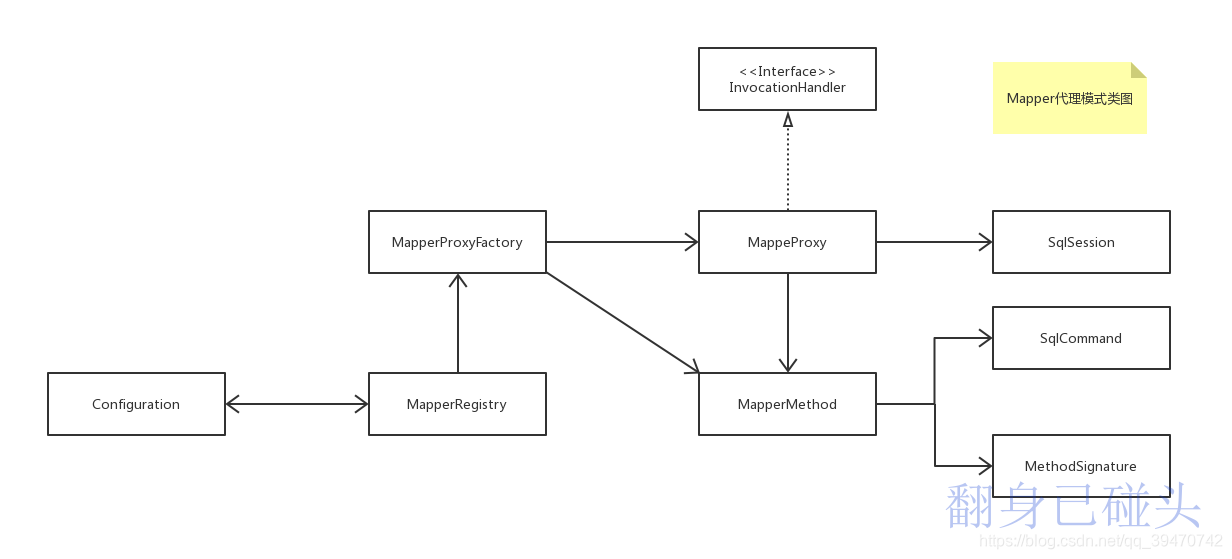Mybatis源码解析之核心类分析
Mybatis源码解析之初始化分析
Mybatis源码解析之执行流程解析
Mybatis源码解析之数据库连接和连接池
Mybatis源码解析之事务管理
Mybatis源码解析之缓存机制(一):一级缓存
Mybatis源码解析之缓存机制(二):二级缓存
Mybatis源码解析之插件机制
一、简介
在mybatis中执行sql时有两种方式,一种是基于statementId,也就是直接调用SqlSession的方法,如sqlSession.update(“statementId”);
还有一种方法是基于java接口,也是日常开发中最常用的方式。
mapper接口中的每个方法都可以喝mapper xml中的一条sql语句对应,我们可以直接通过调用接口方法的方式进行sql执行。因为mybatis会为mapper接口通过jdk动态代理的方法生成接口的实现类,本篇文章将针对mapper接口的代理展开分析。
以下是mapper接口的代理模式的核心组件的类图。

二、MapperRegistry
MapperRegistry通过Map结构的属性knownMappers中维护着mybatis中所有的mapper接口。
1. MapperRegistry#addMapper(class)
当开发者在配置文件中配置了通过mappers节点的子节点mapper配置了mapper接口时,会调用configuation#addMapper(Class)记录mapper接口,而configuration又委托了MapperRegistry#addMapper(class)处理逻辑。
public <T> void addMapper(Class<T> type) {
if (type.isInterface()) {
if (hasMapper(type)) {
throw new BindingException("Type " + type + " is already known to the MapperRegistry.");
}
boolean loadCompleted = false;
try {
knownMappers.put(type, new MapperProxyFactory<T>(type));
// It's important that the type is added before the parser is run
// otherwise the binding may automatically be attempted by the
// mapper parser. If the type is already known, it won't try.
MapperAnnotationBuilder parser = new MapperAnnotationBuilder(config, type);
parser.parse();
loadCompleted = true;
} finally {
if (!loadCompleted) {
knownMappers.remove(type);
}
}
}
}
可以看到,MapperRegistry以mapper接口的类型为key值,将接口类型封装成MapperProxyFactory作为value值放入knownMappers。
2. MapperRegistry#getMapper(Class, SqlSession)
该方法基于SqlSession参数向外提供了对应类型的mapper接口的对象。
public <T> T getMapper(Class<T> type, SqlSession sqlSession) {
final MapperProxyFactory<T> mapperProxyFactory = (MapperProxyFactory<T>) knownMappers.get(type);
if (mapperProxyFactory == null) {
throw new BindingException("Type " + type + " is not known to the MapperRegistry.");
}
try {
return mapperProxyFactory.newInstance(sqlSession);
} catch (Exception e) {
throw new BindingException("Error getting mapper instance. Cause: " + e, e);
}
}
根据mapper接口类型找到对应的MapperProxyFactory时,调用其newInstance方法得到对应的对象返回。
三、MapperProxyFactory
public class MapperProxyFactory<T> {
private final Class<T> mapperInterface;
private final Map<Method, MapperMethod> methodCache = new ConcurrentHashMap<Method, MapperMethod>();
public MapperProxyFactory(Class<T> mapperInterface) {
this.mapperInterface = mapperInterface;
}
public Class<T> getMapperInterface() {
return mapperInterface;
}
public Map<Method, MapperMethod> getMethodCache() {
return methodCache;
}
@SuppressWarnings("unchecked")
protected T newInstance(MapperProxy<T> mapperProxy) {
return (T) Proxy.newProxyInstance(mapperInterface.getClassLoader(), new Class[] { mapperInterface }, mapperProxy);
}
public T newInstance(SqlSession sqlSession) {
final MapperProxy<T> mapperProxy = new MapperProxy<T>(sqlSession, mapperInterface, methodCache);
return newInstance(mapperProxy);
}
}
如果对jdk动态代理有一定了解,很容易就能看出来MapperProxyFactory的newInstance方法是很典型的生成代理对象的方式。
四、MapperProxy
MapperProxy作为InvocationHandler的实现类,是jdk动态代理模式的核心。
1. MapperProxy#invoke(Object, Method, Object[])
@Override
public Object invoke(Object proxy, Method method, Object[] args) throws Throwable {
try {
if (Object.class.equals(method.getDeclaringClass())) {
return method.invoke(this, args);
} else if (isDefaultMethod(method)) {
return invokeDefaultMethod(proxy, method, args);
}
} catch (Throwable t) {
throw ExceptionUtil.unwrapThrowable(t);
}
final MapperMethod mapperMethod = cachedMapperMethod(method);
return mapperMethod.execute(sqlSession, args);
}
private MapperMethod cachedMapperMethod(Method method) {
MapperMethod mapperMethod = methodCache.get(method);
if (mapperMethod == null) {
mapperMethod = new MapperMethod(mapperInterface, method, sqlSession.getConfiguration());
methodCache.put(method, mapperMethod);
}
return mapperMethod;
}
对于Object方法和default方法,执行原方法逻辑即可。
对于对于sql语句的方法,交给MapperMethod 处理。
五、MapperMethod
Mapper类负责去处理mapper接口中的sql方法。
public Object execute(SqlSession sqlSession, Object[] args) {
Object result;
switch (command.getType()) {
case INSERT: {
Object param = method.convertArgsToSqlCommandParam(args);
result = rowCountResult(sqlSession.insert(command.getName(), param));
break;
}
case UPDATE: {
Object param = method.convertArgsToSqlCommandParam(args);
result = rowCountResult(sqlSession.update(command.getName(), param));
break;
}
case DELETE: {
Object param = method.convertArgsToSqlCommandParam(args);
result = rowCountResult(sqlSession.delete(command.getName(), param));
break;
}
case SELECT:
if (method.returnsVoid() && method.hasResultHandler()) {
executeWithResultHandler(sqlSession, args);
result = null;
} else if (method.returnsMany()) {
result = executeForMany(sqlSession, args);
} else if (method.returnsMap()) {
result = executeForMap(sqlSession, args);
} else if (method.returnsCursor()) {
result = executeForCursor(sqlSession, args);
} else {
Object param = method.convertArgsToSqlCommandParam(args);
result = sqlSession.selectOne(command.getName(), param);
}
break;
case FLUSH:
result = sqlSession.flushStatements();
break;
default:
throw new BindingException("Unknown execution method for: " + command.getName());
}
if (result == null && method.getReturnType().isPrimitive() && !method.returnsVoid()) {
throw new BindingException("Mapper method '" + command.getName()
+ " attempted to return null from a method with a primitive return type (" + method.getReturnType() + ").");
}
return result;
}
MapperMethod还有一个静态内部类MethodSignature用作mapper方法的标签,SqlCommand用作sql命令。
可以看到,根据sql命令的类型(insert|update|delete|select|flush)和返回类型分别调用SqlSession的不同方法,然后对insert|update|delete方法的返回值做适配。
2. MapperMethod#rowCountResult(int)
private Object rowCountResult(int rowCount) {
final Object result;
if (method.returnsVoid()) {
result = null;
} else if (Integer.class.equals(method.getReturnType()) || Integer.TYPE.equals(method.getReturnType())) {
result = rowCount;
} else if (Long.class.equals(method.getReturnType()) || Long.TYPE.equals(method.getReturnType())) {
result = (long)rowCount;
} else if (Boolean.class.equals(method.getReturnType()) || Boolean.TYPE.equals(method.getReturnType())) {
result = rowCount > 0;
} else {
throw new BindingException("Mapper method '" + command.getName() + "' has an unsupported return type: " + method.getReturnType());
}
return result;
}
insert|update|delete方法方法的返回值就是sql命令的匹配行数,而在mapper方法中支持Integer、Long、Boolean和void类型的返回,因此做简单适配。